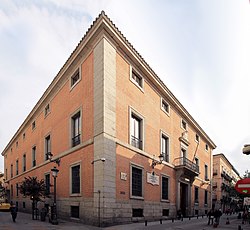Real Academia de la Historia
| Royal Academy of History | |
|---|---|
|
Native name Spanish: Real Academia de la Historia 
|
|
 |
|
| Location | Madrid, Spain |
| Coordinates | 40°24′48″N 3°41′56″W / 40.413466°N 3.698992°WCoordinates: 40°24′48″N 3°41′56″W / 40.413466°N 3.698992°W |
| Official name: Real Academia de la Historia | |
| Type | Non-movable |
| Criteria | Monument |
| Designated | 1945 |
| Reference no. | RI-51-0001170 |
Real Academia de la Historia (English: Royal Academy of History) is a Spanish institution based in Madrid that studies history "ancient and modern, political, civil, ecclesiastical, military, scientific, of letters and arts, that is to say, the different branches of life, of civilisation, and of the culture of the Spanish people".
The Academy was established in 1738. Since 1836 it has occupied an 18th-century building designed by the neoclassical architect Juan de Villanueva. The building, which was originally occupied by the Hieronymites, had become available as a result of the Ecclesiastical confiscations of Mendizábal.
As formerly the main Spanish institution for antiquaries, the Academy retains significant libraries and collections of antiquities, which cannot be seen by the public. The keeper of antiquities is the prehistorian Martín Almagro Gorbea.
Items held include:
Some Spanish historians have considered it an obsolete misogynist institution, that still considers history as a matter of kings and battles. However, the image has changed since Gonzalo Anes was director.
In 2011 the Academy published the first 20 volumes of a dictionary of national biography, the Diccionario Biográfico Español, to which some five thousand historians contributed. The publicly funded publication has been subject of controversy for failing to achieve the standards of objectivity associated with, for example, the Oxford Dictionary of National Biography. The British Dictionary restricted itself to persons who were deceased, and the historian Henry Kamen has argued that it was a mistake for its Spanish equivalent to include living figures among entries. However, while there was criticism of entries for some living people (such as the politician Esperanza Aguirre), the main allegations of bias concern articles relating to Francoist Spain. A notable example is the entry on Francisco Franco, written by Luis Suárez Fernández, in which Franco is defined as an autocratic head of state rather than a dictator. In contrast, the administration of the democratically elected President Negrín is described as dictatorial.
...
Wikipedia

